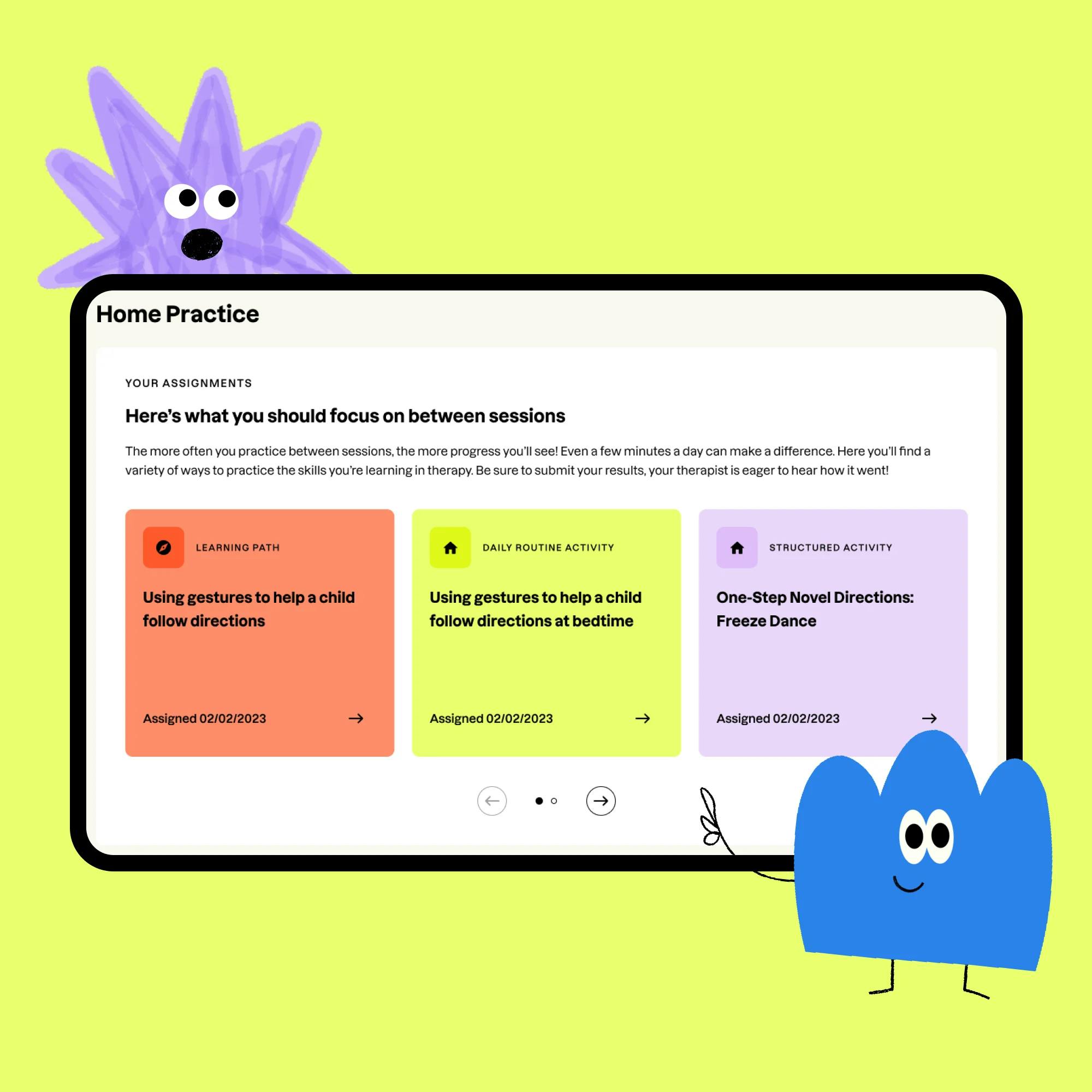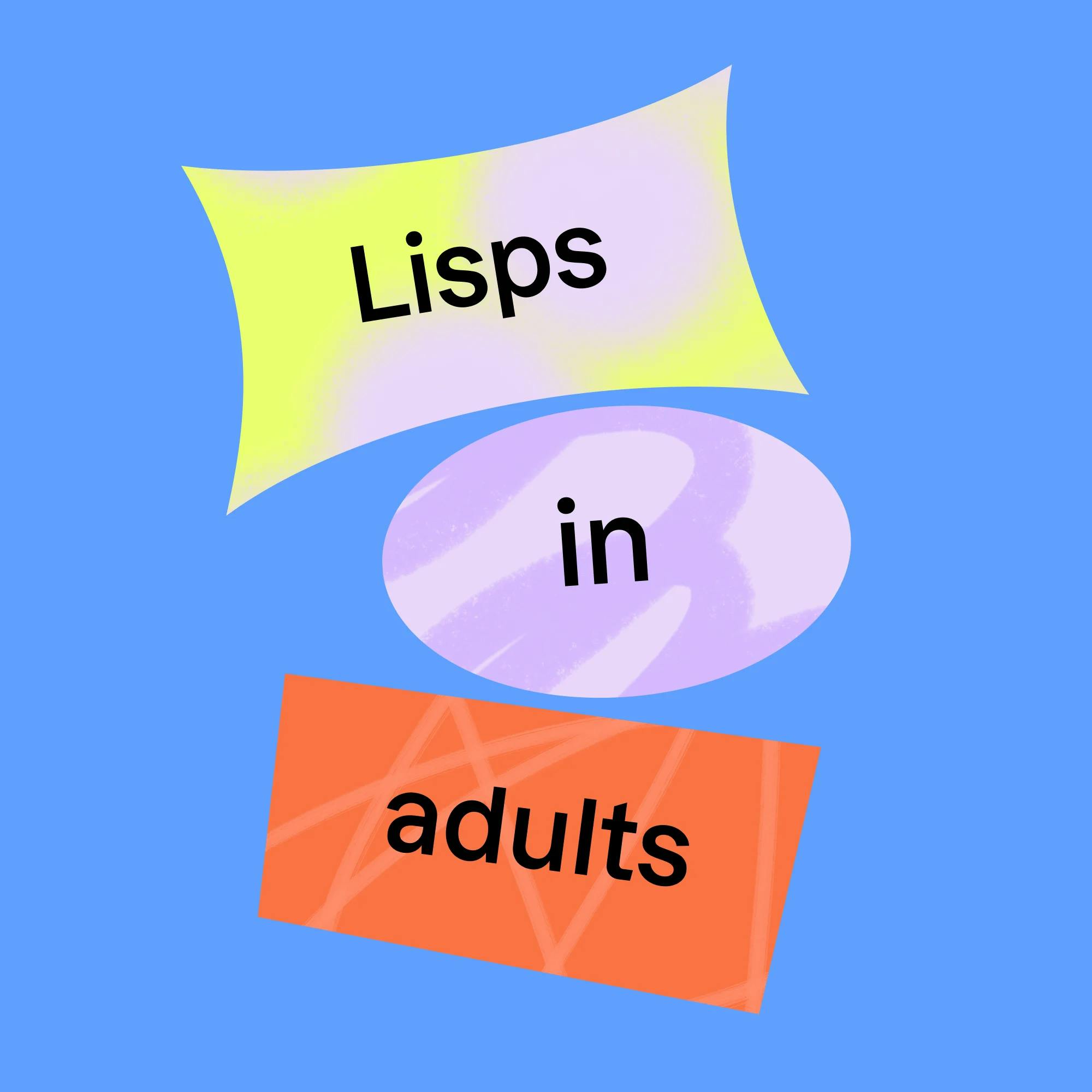When young children are learning to talk, speech errors are a normal part of their development. Lisps are one of the most noticeable speech disorders during this phase. Children with a lisp often struggle to pronounce certain consonants, especially the /s/ and /z/ sounds.
The number one question parents usually ask is “Will my child grow out of a lisp?” In many cases, lisps are temporary bumps on the road to language development, and they go away on their own. However, while a lisp might seem cute in a toddler, it can be concerning if it persists. Speaking with a lisp can affect a child’s confidence and self-esteem, through their school years and beyond.
Fortunately, a lisp can be fixed–at any age! We’ve put together this informational guide to answer common questions about lisps, describe what a lisp sounds like, and explain how a lisp is evaluated, diagnosed, and treated.
Free speech check
How well is your child speaking for their age? Find out with our free 5-minute online screener. No signup required, just answers.
 Start the screener
Start the screenerWhat is a lisp?
Many of us know what a lisp sounds like. The most common form occurs when someone makes a “th” sound when trying to say an “s” or “z” sound.
A lisp happens when a person’s tongue is placed incorrectly inside their mouth during speech. When a person lisps, their tongue usually touches, pushes against, or protrudes between their teeth.
Lisps often become noticeable after the age of 2, when children begin developing their language abilities. While it’s always a good idea to talk with a speech-language pathologist if you think your child has a lisp, it’s especially important once your child is close to age 5.


What are the types of lisps?
There are actually four distinct types of lisps, with certain characteristics and tongue placement. While the differences may seem small, correct diagnosis is important for treatment.
Here are the four types of lisps:
1 Palatal lisp
This lisp is associated with a person’s soft palate, also known as the roof of the mouth. When a person’s tongue rolls back and touches the roof of their mouth during speech, they often have difficulty making /s/ and /z/ sounds.

2 Lateral lisp
A lateral lisp happens when a person’s tongue remains in a close-to-normal position, but airflow manages to escape from one or both sides of their mouth. This is sometimes referred to as a “slushy lisp” because it can make the speaker’s words sound “wet” or “spitty.” What you’re hearing is a mix of air and saliva.

3 Dentalized lisp
With a dentalized lisp, a person’s tongue pushes against their front teeth, directing airflow forward. This commonly produces a “muffled” sound.

4 Interdental lisp
These are often referred to as frontal lisps. An interdental lisp happens when the tongue pushes forward or protrudes between the front teeth.

Both dentalized and interdental lisps are common during a child's language development phase. Many children have this type of lisp until around 4½ years of age.
However, lateral and palatal lisps do not happen as part of a child’s natural development. A child with this type of lisp should receive an evaluation from a speech therapist as soon as possible.
What causes a lisp?
Lisps result from the incorrect placement of the tongue in the mouth. This can obstruct air flow when speaking, and distort how a person pronounces words and syllables.
Lisps can be caused by a variety of factors, including:
Learning to pronounce sounds and syllables incorrectly
Problems with a person’s jaw alignment
A tongue tie, which occurs when the tongue is attached to the bottom of the mouth and its movement is limited
A tongue thrust, where the tongue protrudes between a person’s teeth


Is there a difference between a tongue thrust and a lisp?
While a lisp can be a result of a tongue thrust, there is a difference between a tongue thrust and lisp. The distinction can be hard to identify and should be determined by a speech therapist.
A tongue thrust is an orofacial myofunctional disorder (OMD). It occurs when the tongue moves forward in a pronounced way when a person is speaking or swallowing. The tongue may sit too far forward in the mouth, or push between a person’s teeth during speech and swallowing.
As with a lisp, articulation errors can result from a tongue thrust, affecting how the person produces sounds.


How can a lisp affect a person’s life?
Lisping often doesn’t have a severe impact on a person’s ability to be understood. However, a lisp can still affect a person’s social and emotional wellbeing.
Some caregivers fear their child could be teased by their peers. Children with a lisp may feel anxious or uncomfortable when speaking with other people. This can affect their confidence, self-esteem, and ability to socialize with others.
For adults with a lisp, these effects can be worse. They may feel frustrated or embarrassed when speaking at work. They may try to avoid certain social situations altogether.
Lisps affect everyone differently, and not everyone wants to get rid of a lisp. However, there are things that parents and adults can do to minimize the impact of a lisp.


How are lisps recognized and diagnosed?
In most cases, your child’s pediatrician, school nurse, or teacher may refer you to a speech therapist. Speech therapists are communication experts and are the most qualified professionals to assess, evaluate, and treat people with lisps.
As mentioned, there are different types of lisps of varying severities. If you suspect your child has a lisp, it’s a good idea to be proactive and seek an evaluation from a speech therapist.
At Expressable, your speech therapist may do the following during an evaluation for a lisp:
Review your or your child’s medical history
Examine the anatomy of the mouth and tongue placement
Check for issues like a tongue tie or tongue thrust
Observe your or your child’s speech fluency, vocal quality, and social communication skills
Determine whether a lisp or a different type of speech sound disorder is present
Provide a professional opinion of when to start intervention; for example, they may recommend delaying treatment and monitoring your child to see if the lisp naturally disappears over time
How are lisps treated?
Habits become harder to break over time. That means the earlier speech therapy begins, the more quickly a lisp can be fixed and overall communication will improve.
Once your speech therapist identifies the type of lisp that’s present, they’ll develop a tailored treatment plan. This plan will often include helping the person:
Increase their awareness of where they’re placing their tongue when speaking
Hear and recognize the difference between correct and incorrect pronunciation of sounds and syllables
Correctly make the target sounds they’re struggling to pronounce
Correctly pronounce more complex language, such as consonant and vowel combinations, structured and spontaneous sentences, and more
Practice using these correct pronunciations in real-life settings outside of therapy sessions
Concerned about your child's speech?
We're here for you. Get matched with a speech therapist who's experienced in your child's area of need and available when you are.
 Find a speech therapist
Find a speech therapistAt Expressable, speech therapists use a variety of techniques to improve a lisp. Different types of cues and techniques work for different people.
You’ll likely focus on placement practice, or learning how the different parts of the mouth are used to make speech sounds. In speech therapy for a lisp, some children respond well to a verbal cue, such as a reminder to “use your ‘snake’ sound.” A gestural cue can also be helpful, like dragging one finger down the arm to indicate a long, hissing sound.
As the person learns to make the target sounds, the speech therapist will decrease the amount of help provided. This increases the person’s independence in their speech sound productions, which is the whole goal of speech therapy.
Through the Expressable portal, you'll get weekly practice activities tailored to your needs. The more you practice at home, the faster you'll make progress!
As your independence grows, your speech therapist will also increase the complexity of tasks you’re working on. For example, at the beginning of therapy you may work on the /s/ sound by itself, not in words. Over time, you will likely move on to practicing /s/ in sentences and conversation. Your Expressable speech therapist will teach you self-monitoring and self-correcting techniques so you can use your new skills in everyday conversations.
In addition, all Expressable clients have access to our client portal, which features educational Learning Paths covering the strategies taught in therapy sessions. You can access examples, tips, demo videos, quizzes, and more. Plus, through the portal, you'll receive weekly home practice activities tailored to your needs. The more you practice speech therapy techniques at home, between sessions, the faster you'll make progress!


How does online speech therapy work for a lisp?
Expressable matches families and adults with a certified speech therapist trained in their area of need. All therapy is delivered online via face-to-face video conferencing.
The client’s age and development will influence how the speech therapist interacts with them during sessions:
Ages 0-3: Caregivers attend sessions and work directly with their child's speech therapist to learn cues and at-home strategies. This way they can confidently practice with their child outside the sessions and help their child make progress.
Ages 3-6: Caregivers attend video sessions alongside their child so they both learn valuable skills from their speech therapist. Reinforcing these lessons outside the session will continue to promote skill-building.
Ages 7 and up: Most children attend video sessions independently, but parents are kept in the loop with updates and tips during each session.
Adults: Adults attend sessions by themselves, but they are welcome to bring loved ones or family members as well.


Can adults correct a lisp?
First things first: It’s never too late to “fix” a lisp.
Many adults have a lisp that wasn’t properly treated in their younger years. They may have feelings of frustration, embarrassment, or low self-esteem, and they want to get rid of their lisp to feel more confident when speaking.
However, it’s also important to note that not all adults want to fix their lisp--and that’s perfectly OK! Often, these adults have accepted their speech the way it is. It's become part of their unique image and persona.
Not all adults want to fix their lisp--and that’s perfectly OK!
Assessing and treating lisps is largely similar in both children and adults, beginning with seeking professional help from a speech therapist. The only added challenge with adults is finding someone you can practice with outside of therapy sessions. Whether this is a spouse, family member, or friend, it’s important to have someone you trust provide honest feedback and encouragement so you can continue to improve your lisp.
If you’re considering speech therapy for yourself, reach out to Expressable! We’ll answer your questions and help you decide on next steps. Connect with us here.


How long does it take to correct a lisp?
Every person is different, and the frequency and intensity of speech therapy will shift depending on their needs. Some children can see big improvement in a month or two. Others will need speech therapy for a year or more. In most cases, the recommended frequency for speech therapy for a lisp is two sessions per week.
Factors that can affect the length of treatment include:
The person’s age
Type of lisp
The person’s awareness of mispronunciations and ability to self-correct
How well they follow directions
How often they practice at home


Home exercises to help fix a lisp
As with all speech and language issues, practicing once or twice a week with a speech therapist simply isn’t enough. Overcoming old habits takes regular reinforcement. When you practice between sessions, or help your child practice, you’ll see faster progress!
Your speech therapist will provide personalized recommendations for at-home practice. However, here are a few tips and techniques you can try to help correct a lisp.
Model correct speech for your child: Children are sponges. They pick up speech habits by watching and interacting with people they love--namely, their family. So it’s important to “model” correct speech when speaking with your child.
Make sure that you speak slowly, clearly, and with correct pronunciation. In addition, maintain eye contact with your child, even if you have to kneel down to get on their level. That way they can see how your mouth moves and how you form sounds.
Use a mirror: Position your child in front of a mirror so each of you can practice pronouncing the “s” and “z” sounds. Watch how your teeth and mouth move when pronouncing these sounds, and encourage your child to imitate your correct mouth movements. This technique is helpful for anyone, but especially those who are more visual learners. Adults with a lisp can benefit from using a mirror, too!


Try the butterfly technique: This is a common technique used in speech therapy that can be easily practiced at home. To do it, prolong the letter “i” when you say words like “chin” or “win.” Notice how the sides of your tongue slightly raise upward like a butterfly’s wings. When pronouncing the /s/ and /z/ sounds, our tongue should be in the same position. The goal of this exercise is to help prevent the tip of the tongue from protruding past the teeth.
Drink from a straw: For people with dentalized and interdental lisps in particular, it can be helpful to use a straw when drinking. Straws naturally force the tongue to pull back into the mouth, which can help increase oral-motor strength. If you’re not a big fan of wasting so much plastic, spend a few dollars on a reusable, eco-friendly metal straw that can be washed.
Try to stop your child’s thumb-sucking: While thumb-sucking is a natural instinct, it can lead to lisping or make it worse. This is because thumb-sucking can cause the teeth to shift and create space for the tongue to protrude forward. Instead, try to find a comforting replacement that your child loves, such as a toy or blanket.


Get started with Expressable
If you’re considering speech therapy for a lisp for yourself or your child, contact Expressable today. We’re here to answer your questions and help you decide on next steps. Start our simple sign-up here!
How Expressable Can Help
Concerned your child isn't reaching age-expected milestones? Looking for communication support from a professional? Expressable is a national online speech therapy practice serving children and adults. We treat all major areas of communication and feeding, offer flexible hours including evenings and weekends, and accept most major health insurance plans. We’re proud to have earned more than 3,000 5-star reviews from our clients (4.9/5 average).
Our therapy model is centered on parent and caregiver involvement. Research proves that empowering caregivers to participate in their loved one’s therapy leads to better outcomes. That’s why we combine live, 1-on-1 speech therapy with personalized education and home practice activities for faster progress.
Communication is more than words. It’s how we share how we feel and show who we are. We’re here to help you or your child do just that.
 Alexis Irazoque, M.S., CCC-SLP
Alexis Irazoque, M.S., CCC-SLP









